RPM 1/35 SdKfz 135/1 15cm Howitzer SPG (Normandy version)
|
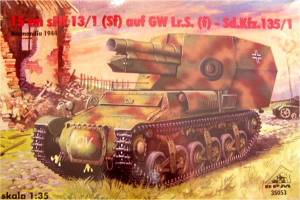 |
The SdKfz 135/1
Germany had on hand 160 captured Lorraine Schlepper vehicles in May
of 1942. It was decided that 40 of these be used to mount the 15 cm heavy
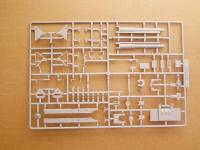 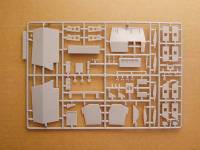 field
howitzer. The first 30 produced were sent to Rommel's Afrika Korps in
Libya. All were eventually lost in the battles for and subsequent retreat
from El Alamein. 64 more vehicles were refurbished and converted during
July and August of 1942. Subsequently reorganized as part of 21st Panzer
Division; Panzer-Artillerie-Regiment 155 and Panzer-Grenadier Regiments
125 and192 had 24 vehicles available at the start of the Normandy campaign.
Almost all were lost during the battles across France in June, July, and
August of 1944. field
howitzer. The first 30 produced were sent to Rommel's Afrika Korps in
Libya. All were eventually lost in the battles for and subsequent retreat
from El Alamein. 64 more vehicles were refurbished and converted during
July and August of 1942. Subsequently reorganized as part of 21st Panzer
Division; Panzer-Artillerie-Regiment 155 and Panzer-Grenadier Regiments
125 and192 had 24 vehicles available at the start of the Normandy campaign.
Almost all were lost during the battles across France in June, July, and
August of 1944.
The Kit
The box art painting shows a 3-color camouflaged vehicle. The kit consists
of 301 parts on 5 sprues, 1 sprue with 64 individual track links, and
1 pair of black soft "vinyl" tracks. A 7 page, no text instruction
sheet, painting guide, parts map and small sheet of decals complete the
contents. Paint and marking schemes for 3 vehicles serving in Normandy
in 1944 are shown. Overall, detail is 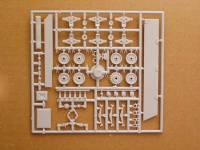 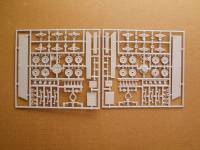 "soft",
generally not crisp and clean. The sprues with the suspension parts are
better than the hull and gun parts, and are a different shade of plastic,
as well as a different hardness. Shrinkage dimples are evident on several
of the thicker parts. There are a large number of shackles to be installed
on the suspension leaf springs. Some are incompletely molded; all have
thick attachment points. Ejector pin marks are generally shallow on my
example, some will be hidden by further construction. There is a moderate
amount of flash on the wheel and hull parts. My review kit shows a lot
of surface blemish, possibly from inadequate mold polishing prior to use;
tool and grinding marks are evident. The vinyl tracks are soft and flexible
and were boxed so that they lie flat, eliminating any pressed-in bends.
The guide horns appear too short; they do not match the individual links,
though the difference is small. There is no "soft",
generally not crisp and clean. The sprues with the suspension parts are
better than the hull and gun parts, and are a different shade of plastic,
as well as a different hardness. Shrinkage dimples are evident on several
of the thicker parts. There are a large number of shackles to be installed
on the suspension leaf springs. Some are incompletely molded; all have
thick attachment points. Ejector pin marks are generally shallow on my
example, some will be hidden by further construction. There is a moderate
amount of flash on the wheel and hull parts. My review kit shows a lot
of surface blemish, possibly from inadequate mold polishing prior to use;
tool and grinding marks are evident. The vinyl tracks are soft and flexible
and were boxed so that they lie flat, eliminating any pressed-in bends.
The guide horns appear too short; they do not match the individual links,
though the difference is small. There is no 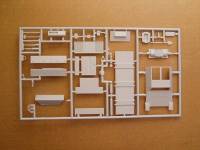 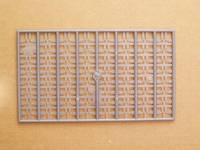 English
suggestion of how to attach the ends together. The pins look to be too
short to use the "heat and squash" method. They may respond
to liquid cement or cyanoacrylate glue. I would recommend testing these
on the track sprue first. Speaking of tracks, the sprue of individual
links appears to be used for making runs of spare track. These are quite
cleanly molded, but suffer from thick attachment points, requiring considerable
care to remove. The instructions are clearly printed, and follow a logical
assembly sequence. They consist of exploded views only. There is no English
text. Parts are not numbered on the sprues, requiring use of the provided
parts map. The decals supplied with my sample are thin, with a nice clear
carrier film. The German crosses and vehicle numbers were printed slightly
out of register. English
suggestion of how to attach the ends together. The pins look to be too
short to use the "heat and squash" method. They may respond
to liquid cement or cyanoacrylate glue. I would recommend testing these
on the track sprue first. Speaking of tracks, the sprue of individual
links appears to be used for making runs of spare track. These are quite
cleanly molded, but suffer from thick attachment points, requiring considerable
care to remove. The instructions are clearly printed, and follow a logical
assembly sequence. They consist of exploded views only. There is no English
text. Parts are not numbered on the sprues, requiring use of the provided
parts map. The decals supplied with my sample are thin, with a nice clear
carrier film. The German crosses and vehicle numbers were printed slightly
out of register.
Conclusion
 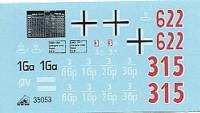 I
was pleased to see a reasonably priced version of this rare, seldom-seen
vehicle produced. RPM is to be commended for taking on this project. I
would recommend this kit to experienced modelers who are willing and able
to work around the shortcomings of this kit. With care and patience, a
good representation of an unusual armored vehicle can be built. It could
also form the basis for kit bashing to produce the light howitzer or anti
tank gun versions. Conditionally recommended. I
was pleased to see a reasonably priced version of this rare, seldom-seen
vehicle produced. RPM is to be commended for taking on this project. I
would recommend this kit to experienced modelers who are willing and able
to work around the shortcomings of this kit. With care and patience, a
good representation of an unusual armored vehicle can be built. It could
also form the basis for kit bashing to produce the light howitzer or anti
tank gun versions. Conditionally recommended.
I would like to thank Squadron
for the review kit.
|
|
